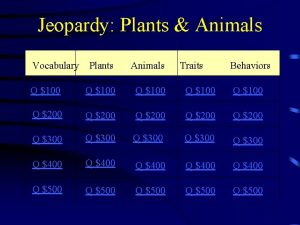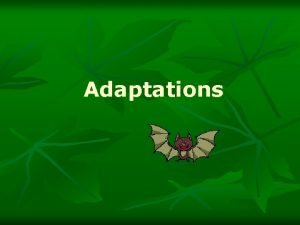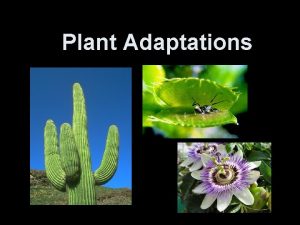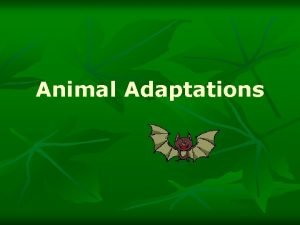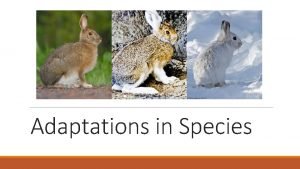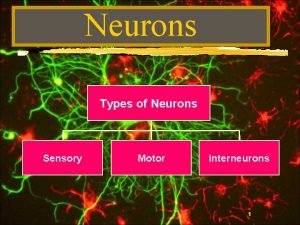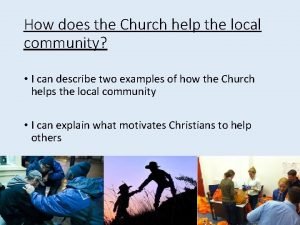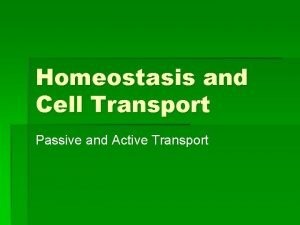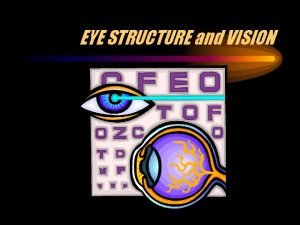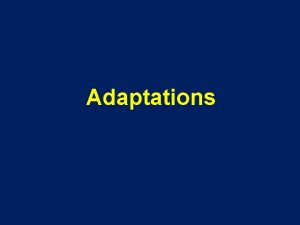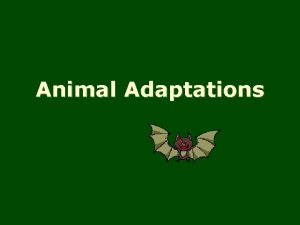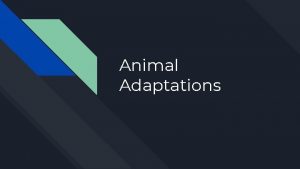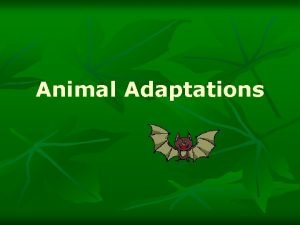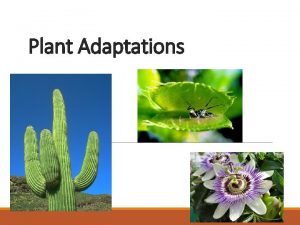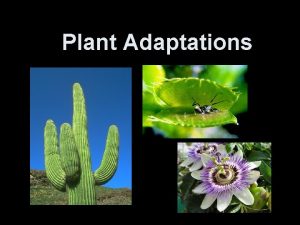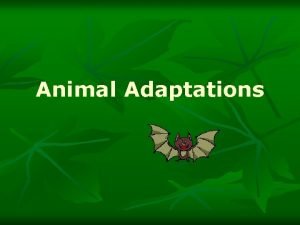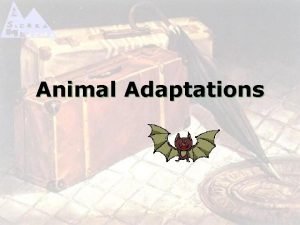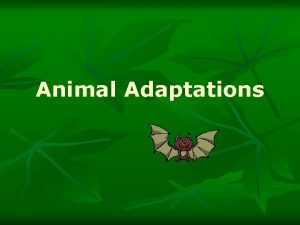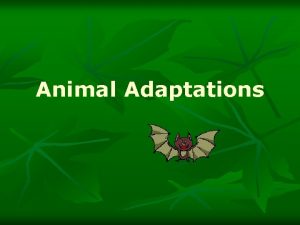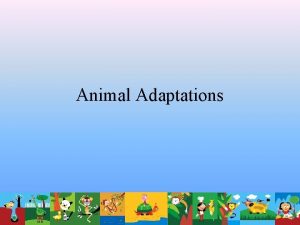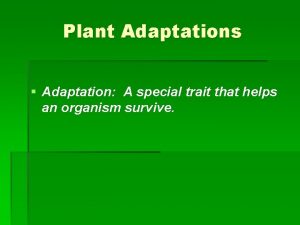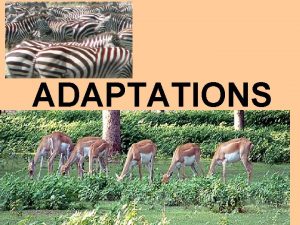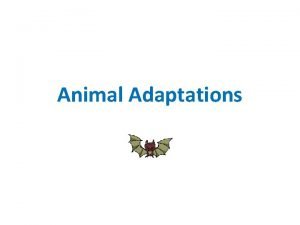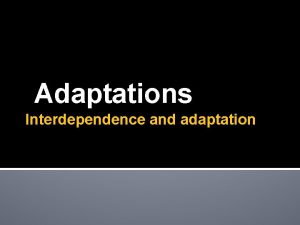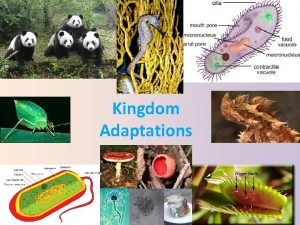Adaptations Types of Adaptation n Anything that helps






























- Slides: 30

Adaptations

Types of Adaptation n Anything that helps an organism survive in its environment Adaptations are inherited from their parents It also refers to the ability of living things to adjust to different conditions within their environments. n n n Structural adaptation Behavioral adaptations Physiological adaptations

Structural adaptations n A structural adaptation involves some part of an organism's body. n n Teeth Body coverings Shells n Quills n Scales n n n Camouflage Mimicry

Example of Adaptation n The shape of an animal’s teeth is related to its diet. n n Herbivores, such as deer, have many molars for chewing tough grass and plants. Carnivores, such as lions, have sharp canines to kill and tear meat.

Camouflage n n Camouflage allows an animal to blend into its environment. Makes it hard for enemies to single out individuals

Mimicry n Mimicry allows one animal to look, sound, or act like another animal to fool predators into thinking it is poisonous or dangerous.

Plant Adaptations n n Vascular-stems Root systems Thorns Leave type n n Broad: absorb more sunlight Small needle-like: reduce water loss Waxy: reduce water loss, protect from fire Poisonous/toxins

Behavioral adaptations n Behavior adaptations include activities or behaviors that help an animal survive. 1. 2. 3. 4. Innate Learned Survival Seasonal

Innate vs. Learned Innate n Inherited through the genes n Examples n n Flying for bees, birds Swimming for fish Walking for humans Speaking for humans Learned n Learned from experience or from observing other animals n Examples n n Type of language spoken for humans Riding a bicycle

Survival Behavior 1. 2. 3. 4. 5. Finding food n Predator-Prey adaptations n Predator-animals that eat other animals n Prey-animal being eaten Marking Territory n Way that animals inform other animals that an area is occupied Defensive Action n Protect resources, themselves, food, mates, offspring Courtship n Behaviors used to find a mate Parenting n Depend on parents for survival

Animal Defense n Some animals use these methods of defense to protect themselves: n n Camouflage n Snake Mimicry n Mexican Milk Snake Bright colors n Skunk and Poison Arrow Frog “Hair” projections n Hedgehog quills n Deer Antlers

Seasonal Behavior Help organisms adapt to the environment 1. Migration 2. Hibernation 3. Estivation 4. Biological Clock n

Migration n n Animals migrate for Adaptation that involves an animal or different reasons. group of animals n better climate moving from one region to another and n better food then back again. n safe place to live n safe place to raise young n go back to the place they were born.

Hibernation n n Period of inactivity in which animal’s body temp. , heart rate, and breathing rate slow down to conserve energy. Bats, woodchucks & bears.

Estivation n Period of inactivity in the summer n n hot, dry places Snakes, lizards, frogs, toads

Biological Clock n Internal control of animal’s natural cycle

Physiological Adaptations n Behaviors controlled by the brain n n n Reflexes Blinking Pain Swallowing Tolerance to a certain poison Logical thinking

Mammals n n warm-blooded All have some type of “hair” n n Some are very specialized, such as white polar bear fur Care for young

Birds n Leg Length n n Foot Webbing n n Roseate Spoonbill (top right) Laughing Gull left) Beak Shape n Long Billed Curlew (bottom) (top

Reptiles n n n cold- blooded Scales Some undergo hibernation and estivation Lay eggs on land Leg structure and position

Amphibians n n Cold-blooded Lay eggs in water Partially of fully webbed feet Have lungs or can absorb oxygen through their skin

Natural Selection and Population Changes Over Time

Natural Selection n n The process by which individuals are better adapted to their environment “Survival of the Fittest” The fittest survive to pass on their traits to the next generation. http: //www. vtaide. com/png/bird. Examples: adaptations 3. htm n n n Insecticide resistance Speciation Galapagos finches

Insecticide Resistance Speciation

Genetics: what is it? n What is genetics? n n “Genetics is the study of heredity, the process in which a parent passes certain genes onto their children. ” What does that mean? n Children inherit their biological parents’ genes that express specific traits, such as some physical characteristics, natural talents, and genetic disorders.

Cell to DNA nucleus chromosome cell base pair (double helix) DNA genes

Genetic Concepts n n Heredity describes how some traits are passed from parents to their children. The traits are expressed by genes, which are small sections of DNA that are coded for specific traits. Genes are found on chromosomes. Humans have two sets of 23 chromosomes—one set from each parent.

Genetic Variation n n Differences that exist naturally among the members of a species Some traits are better suited than others to survive in their environment

I can explain how genetic variations within a population help an organism survive longer.

This powerpoint was kindly donated to www. worldofteaching. com http: //www. worldofteaching. com is home to over a thousand powerpoints submitted by teachers. This is a completely free site and requires no registration. Please visit and I hope it will help in your teaching.
 Character traits jeopardy
Character traits jeopardy Device that makes work easier
Device that makes work easier A student examines the winged insect shown below.
A student examines the winged insect shown below. Phân độ lown
Phân độ lown Block nhĩ thất độ 2 mobitz 2
Block nhĩ thất độ 2 mobitz 2 Thể thơ truyền thống
Thể thơ truyền thống Thơ thất ngôn tứ tuyệt đường luật
Thơ thất ngôn tứ tuyệt đường luật Chiến lược kinh doanh quốc tế của walmart
Chiến lược kinh doanh quốc tế của walmart Tìm vết của đường thẳng
Tìm vết của đường thẳng Hãy nói thật ít để làm được nhiều
Hãy nói thật ít để làm được nhiều Tôn thất thuyết là ai
Tôn thất thuyết là ai Gây tê cơ vuông thắt lưng
Gây tê cơ vuông thắt lưng Sau thất bại ở hồ điển triệt
Sau thất bại ở hồ điển triệt Adaptation example
Adaptation example Types of structural adaptations
Types of structural adaptations What are the 3 types of adaptations
What are the 3 types of adaptations Structural adaptation examples
Structural adaptation examples Adaptations of lotus plant
Adaptations of lotus plant History helps us to understand other people
History helps us to understand other people Strategic order of main points
Strategic order of main points Fatty casing that helps speed neurotransmission
Fatty casing that helps speed neurotransmission Mcdp-1 defines trust as a product of
Mcdp-1 defines trust as a product of What can churches do to help the community
What can churches do to help the community How does diffusion help maintain homeostasis?
How does diffusion help maintain homeostasis? 3 layers of the eye
3 layers of the eye What court helps congress exercise its power
What court helps congress exercise its power The health triangle
The health triangle Principle of size separation
Principle of size separation How repetition helps to unify a design?
How repetition helps to unify a design? ___________ helps in managing lifecycles on cluster node.
___________ helps in managing lifecycles on cluster node. Avoiding plagiarism uts
Avoiding plagiarism uts
